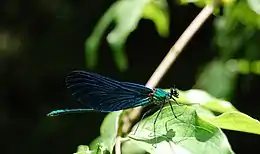
_(-mini_map).svg.png.webp)
The list of Odonata species of Slovenia includes 72 species of dragonflies and damselflies (Slovene: kačji pastirji) for which reliable records exist from the present-day territory of Slovenia, including one that has not been seen since the 1960s and is presumed to have been extirpated (locally extinct), but could have simply been overlooked. The list is based on two reference works: Atlas of the Dragonflies (Odonata) of Slovenia,[2] a joint publication of the Slovene Odonatological Society and the Slovene Centre for Cartography of Fauna and Flora from 1997, and the newer Atlas of the European dragonflies and damselflies (2015),[3] supported by other, more recent publications in which new species described after 1997 were documented.
Odonata species from the territory of present-day Slovenia were systematically studied by the naturalists Johann Weikhard von Valvasor and Giovanni Antonio Scopoli as early as the 17th and 18th centuries; however, the first systematic compendium was only published in the 1960s by the Slovene zoologist Boštjan Kiauta.[1] The distribution of Odonata in Slovenia is now fairly well known by international standards, with Slovenia having been one of the first European countries for which a full account of faunistic data (an "atlas") was published. The number of species (72) represents almost exactly half of the European species (143) and is comparable with the number of species of Germany (81) and Spain (80), both much larger countries.[3] Slovenian odonate fauna is therefore considered highly diverse, which is attributed to the country's position on the junction of several ecoregions where many species reach the border of their distribution.[1]
The list
Taxonomic order and nomenclature follow the Atlas of the European dragonflies and damselflies (2015),[3] while Atlas of the Dragonflies (Odonata) of Slovenia is the primary source of the data,[2] with notes explaining discrepancies.
Columns with scientific and vernacular names in English and Slovene are followed by conservation status as determined by the country's official Red list of Odonata (Rdeči seznam kačjih pastirjev).[4] Categories of conservation status according to this list are as follows:
- extinct species (EX): once reliably recorded native populations that have been exterminated in the past throughout the whole territory of the Republic of Slovenia.
- presumed extinct species (EX?): once reliably recorded native populations which haven't been seen for a longer period despite targeted searching, providing grounds for the presumption of local extinction.
- endangered species (E): the existence of this species on the territory of Slovenia is not likely in the future if the reasons for endangerment are not removed. Population size is critically low or is rapidly diminishing in a large part of the areal.
- vulnerable species (V): risk of becoming endangered (E) if the negative influences persist. Population size is being reduced in a large part of the areal, whereas the species is sensitive to changes in the environment or inhabits sensitive habitats.
- rare species (R): potentially vulnerable due to its rarity in Slovenia, may rapidly become endangered (E) in case of negative influences.
- non-defined (I): presumed endangered, but there is insufficient data to assign to any of the above categories.
Most (24) of the species included in the Red List are also protected according to the newer Ordinance on protected native species of animals (Uredba o zavarovanih prosto živečih živalskih vrstah) from 2004, which annulled the previous ordinance on which the Red list is based.[5] The protected species are labelled with an additional asterisk (*), while the old Red list statuses are retained for reference.
Most species native to Slovenia are not globally threatened and are regarded least-concern by the International Union for Conservation of Nature (IUCN). There are two exceptions – both Cordulegaster species – that are near-threatened. Additionally, the southern damselfly (Coenagrion mercuriale) is near-threatened as well, but that species is almost certainly extirpated.
Damselflies (Zygoptera)
| Family | Scientific name | Vernacular name in English and Slovene |
Status (SLO) |
Status (IUCN) |
Notes | Photograph |
|---|---|---|---|---|---|---|
| Spreadwings (Lestidae) | Chalcolestes parvidens | eastern willow spreadwing (presenetljiva pazverca) | I | C. parvidens and C. viridis are difficult to distinguish, and were split only in 1997.[3] In the Slovene Atlas they are treated as a single species (both are present in Slovenia). |  | |
| Chalcolestes viridis | willow emerald damselfly (zelena pazverca) | See the note for C. parvidens. |  | |||
| Lestes barbarus | southern emerald damselfly (grmiščna zverca) | V |  | |||
| Lestes dryas | emerald spreadwing (obrežna zverca) | E* |  | |||
| Lestes macrostigma | dark spreadwing (južna zverca) | R* |  | |||
| Lestes sponsa | emerald damselfly (obvodna zverca) |  | ||||
| Lestes virens | small spreadwing (loška zverca) | E* |  | |||
| Sympecma fusca | common winter damselfly (prisojni zimnik) |  | ||||
| Demoiselles (Calopterygidae) | Calopteryx splendens | banded demoiselle (pasasti bleščavec) |  | |||
| Calopteryx virgo | beautiful demoiselle (modri bleščavec) |  | ||||
| White-legged damselflies (Platycnemididae) | Platycnemis pennipes | white-legged damselfly (sinji presličar) |  | |||
| Narrow-winged damselflies (Coenagrionidae) | Ceriagrion tenellum | small red damselfly (rdeči voščenec) | E* |  | ||
| Coenagrion hastulatum | northern damselfly (barjanski škratec) | E* | Thought extirpated in the late 20th century, the species was rediscovered in 1999.[6] | .jpg.webp) | ||
| Coenagrion mercuriale | southern damselfly (brzični škratec) | EX?* | Last recorded by Boštjan Kiauta in the 1960s, the species is cited in the Slovene Atlas as possibly extirpated, while the newer European Atlas no longer lists it. Not included in the total number of species. |  | ||
| Coenagrion ornatum | ornate bluet (koščični škratec) | V |  | |||
| Coenagrion puella | azure damselfly (travniški škratec) |  | ||||
| Coenagrion pulchellum | variable damselfly (suhljati škratec) | V | .jpg.webp) | |||
| Coenagrion scitulum | dainty damselfly (povodni škratec) | V |  | |||
| Enallagma cyathigerum | common blue damselfly (bleščeči zmotec) | .jpg.webp) | ||||
| Erythromma lindenii | goblet-marked damselfly (prodni paškratec) | V | .jpg.webp) | |||
| Erythromma najas | red-eyed damselfly (veliki rdečeokec) |  | ||||
| Erythromma viridulum | small red-eyed damselfly (mali rdečeokec) |  | ||||
| Ischnura elegans | blue-tailed damselfly (modri kresničar) |  | ||||
| Ischnura pumilio | scarce blue-tailed damselfly (bledi kresničar) | 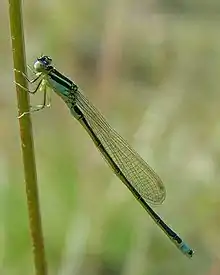 | ||||
| Pyrrhosoma nymphula | large red damselfly (rani plamenec) |  |
Dragonflies (Anisoptera)
| Family | Scientific name | Vernacular name in English and Slovene |
Status (SLO) |
Status (IUCN) |
Notes | Photograph |
|---|---|---|---|---|---|---|
| Hawkers (Aeshnidae) | Aeshna affinis | southern migrant hawker (višnjeva deva) | V |  | ||
| Aeshna caerulea | azure hawker (šotna deva) | R* | Only one record for Slovenia |  | ||
| Aeshna cyanea | southern hawker (zelenomodra deva) |  | ||||
| Aeshna grandis | brown hawker (rjava deva) | V | .jpg.webp) | |||
| Aeshna isoceles | green-eyed hawker (deviški pastir) | V | 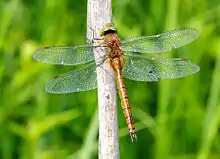 | |||
| Aeshna juncea | common hawker (barjanska deva) | V |  | |||
| Aeshna mixta | migrant hawker (bleda deva) |  | ||||
| Aeshna subarctica | subarctic darner (mahovna deva) | R* | [7] |  | ||
| Aeshna viridis | green hawker (zelena deva) | E* |  | |||
| Anax ephippiger | vagrant emperor (afriški minljivec) |  | ||||
| Anax imperator | emperor dragonfly (veliki spremljevalec) |  | ||||
| Anax parthenope | lesser emperor (modroriti spremljevalec) |  | ||||
| Brachytron pratense | hairy dragonfly (zgodnji trstničar) | V |  | |||
| Clubtails (Gomphidae) | Gomphus flavipes | yellow-legged dragonfly (rumeni porečnik) | EX?* | Thought extirpated in the late 20th century, rediscovered in 2011;[8] not yet included in the official Red list. | 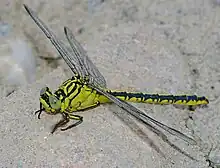 | |
| Gomphus vulgatissimus | common clubtail (popotni porečnik) | V |  | |||
| Lindenia tetraphylla | bladetail (velika peščenka) | EX* | Last recorded by Boštjan Kiauta in 1960s in Fiesa, it is considered extirpated. |  | ||
| Onychogomphus forcipatus | small pincertail (bledi peščenec) |  | ||||
| Ophiogomphus cecilia | green snaketail (kačji potočnik) | V* |  | |||
| Spiketails (Cordulegastridae) | Cordulegaster bidentata | sombre goldenring (povirni studenčar) | V |  | ||
| Cordulegaster heros | balkan goldenring (veliki studenčar) | V* | One of the largest European dragonflies; it was included in the annex of the Habitats Directive when Slovenia joined the European Union. |  | ||
| Emeralds (Corduliidae) | Cordulia aenea | downy emerald (močvirski lebduh) | .jpg.webp) | |||
| Epitheca bimaculata | Eurasian baskettail (nosna jezerka) | V | _20150530.jpg.webp) | |||
| Somatochlora alpestris | alpine emerald (alpski lesketnik) | R* | [9] | 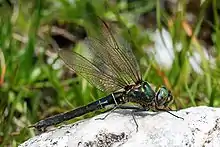 | ||
| Somatochlora arctica | northern emerald (barjanski lesketnik) | R* | 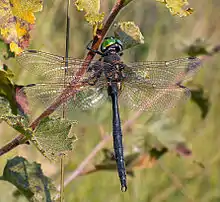 | |||
| Somatochlora flavomaculata | yellow-spotted emerald (pegasti lesketnik) | V |  | |||
| Somatochlora meridionalis | balkan emerald (sredozemski lesketnik) | .jpg.webp) | ||||
| Somatochlora metallica | brilliant emerald (kovinski lesketnik) | E* | .jpg.webp) | |||
| Skimmers (Libellulidae) | Crocothemis erythraea | scarlet dragonfly (opoldanski škrlatec) | 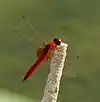 | |||
| Leucorrhinia caudalis | lilypad whiteface (mrtvični spreletavec) | E* |  | |||
| Leucorrhinia dubia | white-faced darter (barjanski spreletavec) | E* | .jpg.webp) | |||
| Leucorrhinia pectoralis | large white-faced darter (dristavični spreletavec) | E* |  | |||
| Libellula depressa | broad-bodied chaser (modri ploščec) |  | ||||
| Libellula fulva | scarce chaser (črni ploščec) | V |  | |||
| Libellula quadrimaculata | four-spotted chaser (lisasti ploščec) | .jpg.webp) | ||||
| Orthetrum albistylum | white-tailed skimmer (temni modrač) |  | ||||
| Orthetrum brunneum | southern skimmer (sinji modrač) |  | ||||
| Orthetrum cancellatum | black-tailed skimmer (prodni modrač) |  | ||||
| Orthetrum coerulescens | keeled skimmer (mali modrač) |  | ||||
| Selysiothemis nigra | black pennant (temni slaniščar) | First sighted in 2012 at Škocjanski zatok nature reserve near Koper;[10] not yet included in the official Red list. | .JPG.webp) | |||
| Sympetrum danae | black darter (črni kamenjak) | E* | .jpg.webp) | |||
| Sympetrum depressiusculum | spotted darter (stasiti kamenjak) | E* |  | |||
| Sympetrum flaveolum | yellow-winged darter (rumeni kamenjak) | R* | .jpg.webp) | |||
| Sympetrum fonscolombii | red-veined darter (malinovordeči kamenjak) |  | ||||
| Sympetrum meridionale | southern darter (sredozemski kamenjak) | R* | 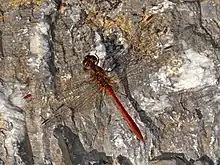 | |||
| Sympetrum pedemontanum | banded darter (pasasti kamenjak) | R* |  | |||
| Sympetrum sanguineum | ruddy darter (krvavordeči kamenjak) |  | ||||
| Sympetrum striolatum | common darter (progasti kamenjak) | .jpg.webp) | ||||
| Sympetrum vulgatum | vagrant darter (navadni kamenjak) |  |
Excluded species
The Slovene Atlas mentions four additional species as records from older literature, but there is insufficient evidence for their presence so they are excluded from that list as well:[2]
- Irish damselfly (Coenagrion lunulatum) – one recorded sighting in the 1950s, but Slovenia lies far outside the species' distribution range so it was most likely misidentified
- large pincertail (Onychogomphus uncatus) – one sighting with a photograph, but the specimen cannot be reliably distinguished from the similar Onychogomphus forcipatus in the picture
- golden-ringed dragonfly (Cordulegaster boltonii) – records from the 1950s belong to Cordulegaster heros which was formally split from C. boltonii in 1979
- northern white-faced darter (Leucorrhinia rubicunda) – one doubtful sighting
References
- 1 2 3 Bedjanič, Matjaž (2003). "Kačji pastirji". In Sket, Boris; Gogala, Matija; Kuštor, Valerija (eds.). Živalstvo Slovenije (in Slovenian). Ljubljana: Tehniška založba Slovenije. pp. 281–289. ISBN 86-365-0410-4.
- 1 2 3 Kotarac, Mladen (1997). Atlas kačjih pastirjev (Odonata) Slovenije z Rdečim seznamom [Atlas of the dragonflies (Odonata) of Slovenia with the Red Data List]. Miklavž na Dravskem polju: Centre for Cartography of Fauna and Flora. ISBN 961-90512-0-3.
- 1 2 3 4 Boudot, Jean-Pierre; Kalkman, Vincent J., eds. (2015). Atlas of the European dragonflies and damselflies. Netherlands: KNNV Publishing. ISBN 978-90-5011-4806.
- ↑ "Pravilnik o uvrstitvi ogroženih rastlinskih in živalskih vrst v rdeči seznam". Uradni list Republike Slovenije (in Slovenian). No. 82. 24 September 2002. - Priloga 21: Rdeči seznam kačjih pastirjev (Odonata)
- ↑ "Uredba o zavarovanih prosto živečih živalskih vrstah". Uradni list Republike Slovenije. No. 46. 30 April 2004. - Priloga 1: Seznam živalskih vrst, katerih živali so zavarovane
- ↑ Bedjanič, Matjaž; Weldt, Saso (2000). "Rediscovery of Coenagrion hastulatum (Charpentier, 1825) in Slovenia (Zygoptera: Coenagrionidae)". Exuviae. 7 (1): 27–30.
- ↑ Bedjanič, Matjaž (1999). "Aeshna subarctica elisabethae Djakonov 1922, new for the odonate fauna of Slovenia (Anisoptera: Aeshnidae)". Exuvia. 6 (1): 7–10.
- ↑ Šácha, Dušan; Bedjanič, Matjaž. "Ponovno odkritje ogroženega rumenega porečnika Gomphus flavipes (Charpentier, 1825) v Sloveniji po pol stoletja (Odonata: Gomphidae)" [Rediscovery of the endangered river clubtail Gomphus flavipes (Charpentier, 1825) in Slovenia after half a century (Odonata: Gomphidae)] (PDF). Natura Sloveniae (in Slovenian). 13 (2): 37–43.
- ↑ Brockhaus, Thomas (1999). "Ein Nachweis von Aeshna subarctica elisabethae Djakonov, 1922 und Somatochlora alpestris (Sélys, 1840) im Hochmoor Šijec auf der Pokljuka, NW Slowenien (Anisoptera: Aeshnidae, Corduliidae)" [A proof of Aeshna subarctica elisabethae Djakonov, 1922 and Somatochlora alpestris (Sélys, 1840) in the Šijec high marsh on Pokljuka, NW Slovenia (Anisoptera: Aeshnidae, Corduliidae)]. Exuviae (in German). 6 (1): 11–13.
- ↑ Šalamun, Ali (2012-08-17). "Kačji pastir temni slaniščar prvič opažen v Sloveniji v Škocjanskem zatoku!" [The black pennant dragonfly first sighted in Slovenia in Škocjanski zatok!] (in Slovenian). Naravni rezervat Škocjanski zatok. Retrieved 2016-04-16.
External links
- Slovene Dragonfly Society (in Slovenian)
- Odonata - pictures in the BioPortal database, maintained by the Centre for Cartography of Fauna and Flora